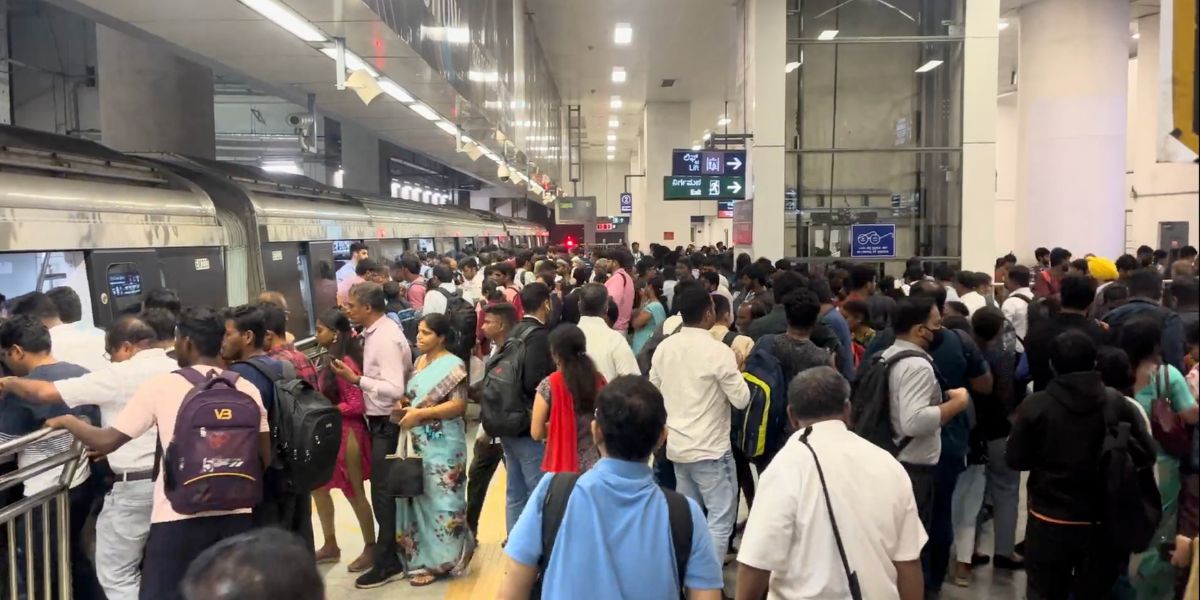With packed metro trains and hardly any space to stand, passengers often face heavy pushing as others try to get inside. This results in uncomfortable and suffocating journeys, leaving commuters frustrated during peak hours.
Published Sep 10, 2025 | 9:42 AM ⚊ Updated Dec 12, 2025 | 5:31 PM

The crowd at a Bengaluru metro station during peak hour.
Synopsis: Daily commuters in Bengaluru’s Namma Metro continue to face severe challenges during peak hours. Passengers often struggle not just to find a seat, but even space to stand inside the trains.
Daily commuters in Bengaluru’s Namma Metro continue to face severe challenges during peak hours between 9 am to 11 am and 5 pm to 8 pm due to overcrowding. The rush is so intense that passengers often struggle not just to find a seat, but even space to stand inside the trains.
Despite the Bengaluru Metro Rail Corporation Limited (BMRCL) expanding its network with new lines across the city, effective crowd management remains a major concern. Commuters on both the purple and green lines face overcrowded trains daily, leading to growing frustration among passengers.
“Travelling via the metro is a daily challenge. The train frequency is fine, but during peak hours it’s completely packed. The management is very bad. At Majestic, it’s horrible; people just rush. Sometimes, because of the crowd, I have to stand on one foot and adjust in different postures,” Diwakar, a regular commuter, told South First.
With packed metro trains and hardly any space to stand, passengers often face heavy pushing as others try to get inside. This results in uncomfortable and suffocating journeys, leaving commuters frustrated during peak hours.
“During peak hours, the metro is so overcrowded that there’s a lot of pushing,”. It becomes very uncomfortable, and sometimes there isn’t even space to stand properly,” another regular commuter, Shilpa, a student, told South First.
Namma Metro began operations in 2011 with three-coach trains, each able to carry around 1,000 passengers. As the city’s population and ridership grew, the system gradually shifted to six-coach trains. The first six-coach train was introduced in June 2018, and by January 2020, all trains were converted to this configuration.
However, Bengaluru Metro’s platforms were built with a maximum length of about 135 metres, which means they can accommodate only six coaches. Extending beyond this is not possible without major infrastructure changes.
“The frequency during peak hours is already good, but that alone doesn’t solve the problem,” another commuter, Ramesh Gowda, told South First. “In a rapidly growing city like Bengaluru, they built platforms that can accommodate only six coaches. Now the trains are running at full capacity and are completely packed. Because of this poor planning, they cannot add more coaches.”
Bengaluru Metro cannot expand beyond six coaches due to platform constraints. Sources said the BMRCL is contemplating the adoption of advanced signalling technology to improve frequency. However, commuters are sceptical about whether this will help to handle the city’s rapid growth in population and ridership in the coming years.
“I’m a senior citizen, and though the metro provides us with dedicated seats, the real challenge is getting inside the train during peak hours. The rush is so overwhelming that even entering the coach feels like a battle. By the time I manage to step in, it becomes nearly impossible to make my way through the crowd to reach those reserved seats. It defeats the very purpose of having them, as seniors like us are often left standing in discomfort,” said a senior citizen commuter.
(Edited by Muhammed Fazil.)
